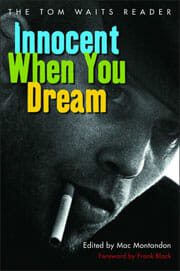
Straight-Talking Liar: Beat raconteur, avant garde floor show, highway spirit, patron saint of the down ‘n’ out
All respect to Mac Montandon for collating these disparate magazine and newspaper articles and broadcast interviews into a seamless read, but it’s the man and his myth that are the main attraction. Tom Waits is a liar: “I’m going to pull your string from time to time,” he understates to Playboy in 1988. But his lies are truer than most people’s truth, and in a bravura performance spanning four decades, Waits’ derelict koans astound, delight and disturb. Even when paired with talented journalists, he quietly fills all the space in the room without ever fully appearing—he’s always shambling late into his own narrative and vanishing when the check arrives. The interviewer kills time with the standard introduction—a blur of tail-finned cars, whiskey and Naugahyde, long fingers worrying the brim of a tattered porkpie hat, rumpled seven-dollar suits and smoldering squares. Eventually, the door creaks open and a pointy shoe portentously enters the frame. Waits eats soup, rambles with casual brilliance and he’s gone.
Waits’ entire life unfolds in this chronologically arrayed volume, and like all tall tales, alternate versions orbit the truth with such complex trajectories that they become indistinguishable: Waits was born in the back of taxicab or a truck (probably neither); he only smokes Viceroys, Kents, Chester?elds. As a child he longed to be an old man, walking with a cane for style, listening to Harry Belafonte records with his friends’ fathers. It’s often reiterated that young Tom had hypersensitive ears, hearing sounds like Van Gogh saw colors—garish, intense and frightening—and would repeat little nonsense mantras to himself when the world got too loud. It’s hard to imagine a more fitting omen for the music he would one day create.
Part One covers the 1970s, the first stage of Waits’ career, where the Beat-influenced songwriter is in full possession of his rasping croon, but has yet to discover the clangorous musical pastiches on which he’ll make his name. In Part Two, Waits’ marriage to songwriting partner Kathleen Brennan—a script editor he meets in the course of his burgeoning acting career—grants him the confidence and vision to produce his classic 1980s experimental trilogy: Swordfishtrombones, Rain Dogs and Frank’s Wild Years, where instead of trying to emulate the world, he pulls it in, building tracks by slamming doors and banging on old car mufflers. By Part Three, Waits is pretty much ignoring questions to read reporters interesting facts he’s amassed in his notebook, performing rarely and still making dazzling, challenging albums.
For all his leg-pulling, it never seems like Waits is patronizing an interviewer. He’s a man of one weather who takes people on their own terms, answering incisive and shallow questions alike with creative gusto. For a consummate liar, that’s an awfully honest way to be, and it’s this practical (if not verbal) lack of pretense that’s kept Waits’ albums fresh and his style evolving, as he pursues his disconcerting visions of squalor and beauty without a thought toward commercial viability. In his own words, “I don’t want to get a weird haircut just because I saw it at the mall.”